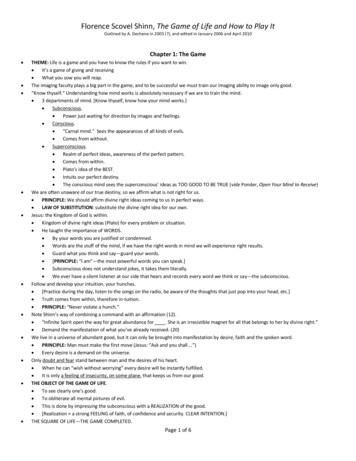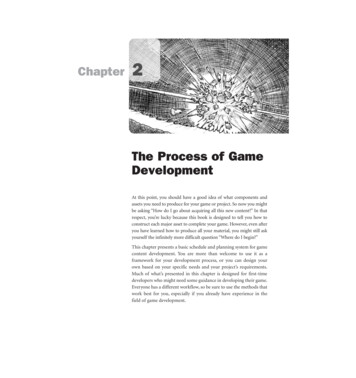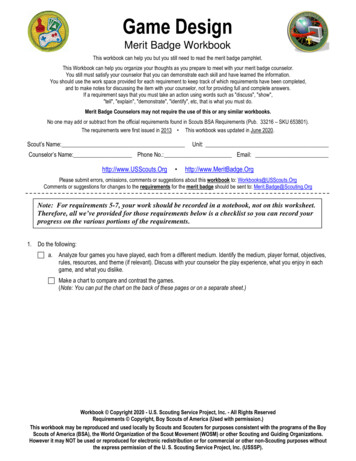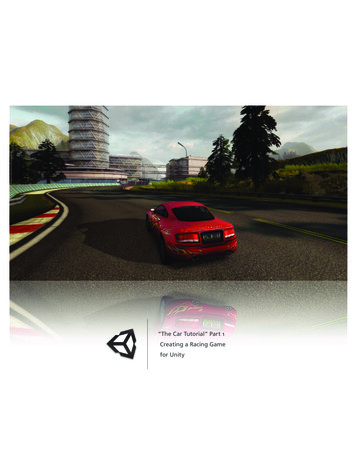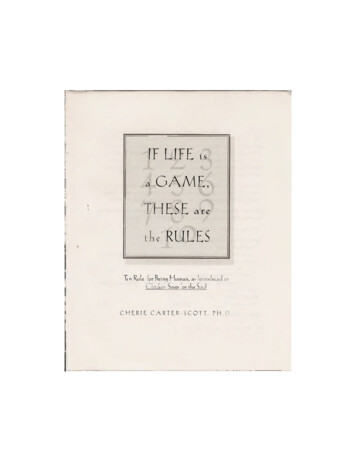
Transcription
IF LIFE isa GAME,THESEa reTen Rules for Being Human,asintroducedinChickenSoupforthe SoulCHERIEC A M R - S C O T T . PHD
II- L I F E IS A G A M E , T H E S EARE T H ERULES. Copyright 1 9 9 8 by CherieCarter-Scott- All rights reserved. Printed in the U n i t e d States o f America. N o part o f thisb o o k may be reproduced or transmitted in any f o r m or by any means, electronic ormechanical, including photocopying, recording, or by any information storage andretrieval system, without written permission from the publisher. F o r information,address Broadway Books, a division o f Bantam Doubleday Dell Publishing Group, Inc.,1 5 4 0 Broadway, N e w York, N Y10036.BROADWAY BOOKS titles may be purchased for business or promotional use or forspecial sales. F o r information, please write to: Special Markets D e p a r t m e n t , BantamDoubleday Dell Publishing Group, Inc., 1 5 4 0 Broadway, N e w York, N Y10036.BROADWAY BOOKS and its logo, a letter B bisected on the diagonal, are trademarks o fBroadway Books, a division o f Bantam Doubleday Dell Publishing Group, Inc.Chicken Soup for the Soul is a registered trademark.Library o f Congress Cataloging-in-Publication D a t aCarter-Scott, Cherie.I f life is a game, these are the rules: ten rules for being human, as introduced inChicken soup for the soul / Cherie C a r t e r - S c o t t . — 1 s t ed.p.cm.I S B N 0 - 7 6 7 9 - 0 2 3 8 - 6 (hardcover)I . C o n d u c t o f life.soul.2 . Spiritual life.3. ned by Songhee Kim98994 . Chicken soup for theI. Title.000102109876CIP
If you came across the Rules for Being Human sometime duringthe last twenty-five years and photocopied them and passed them on toothers; if you used the Rules for a retreat, class curriculum, brochureor Web site; if you framed the rules and put them on your wall, ortucked them in your drawer, or put them on the refrigerator door; ifyou read the Rules and smiled with recognition, then I dedicate thisbook to you and all seekers who have treasured the Rules for BeingHuman for these last twenty five years. This book is to support youand those you love in your journey through Ltfe. Use it as a primerfor higher consciousness. Blessings to you on your path.
Debra Goldstein has been my alter ego throughout the process ofbringing this book into existence. She has been its guardian angel andessential to the quality of the finished product. Lauren Marino has beentotally committed to these Rules becoming a spiritual primer for thoseon the path to higher consciousness. Trigg Robinson, Nancy ClareMorgan, and Donna Gould have been devoted to the world knowing theRules are now explained in detail.My loving, supportive, and dedicated partner, Lynn Stewart, who hashelped me empower people through our workshops for over a quarter ofa century; without her this book would not have been possible.My devoted and loving husband, Michael A. Pomije, who supportsme in all my wishes, hopes, and dreams.
My wonderful daughter, Jennifer Carter-Scott, who is my greatestteacher and toughest critic.Jack Canfield, Mark Victor Hansen, and Patty Aubery, who broughtthe Rules for Being Human into the light.Michael Larsen and Elizabeth Pomada, who believed that this bookhad to be published.To all those who have supported the evolutionary process of thisbook coming into existence: Barbara Adamich, Danita Allen, John Arno,Brook Ashley, Pam Beckerman, Nora Blanco, Jan Campbell, JillianDowling, Jenny Edwards, Connie Fueyo, Bob Furstenau, Penny A.Godlis, Carrell Halley, Katy Jacobson, Elena Johnston, Betty MazettiHatch, Richard Mantei, JoAnn Mermis, Greg Klein, Dan Millman,Terry Myrrdm, Molly Post, Joey Rosenberg, Jeri Rovsek, Julie Simpson,Linda Smukler, Helen Strodl, Maria Weiss, and Mady Widyasurya.Barbara Rasmussen and Roger Hannegan, who celebrate this bookfrom another place.I am grateful for my friends, associates, family, and staff, who have allsupported me.
CONTENTS
xiiCONTENTS
by J a c kCanfieldI have known Dr. Cherie Carter-Scott for over twenty years. I havetaken her workshop, co-sponsored conferences with her, and hadher consult with my organization, and she has been my own personal coach.W h e n we included the Rules for Being Human by "Anonymous"in Chicken Soup for the SoulI had no idea that Cherie was the author.W h e n I learned that she was the author o f the Rules, I was delighted yet not surprised. Cherie is a master facilitator whose life isdedicated to empowering and transforming people's experience o fliving life, so it made perfect sense that she would have created thisastonishingly profound and simple template for understanding life.W h i l e reading this book, you will begin to see your life from a
whole new perspective. I f you embrace the principles in this book,I promise you that your life will magically transform, and that youwill learn the secrets to manifesting your heart's desire.T h e Ten Rules for Being Human will open up many transformational opportunities for you. Enjoy the book, learn the lessons, andbecome a master o f the game o f life.Jack CanfieldCo-author o f Chicken Soup for the Soul'"9
In 1 9 7 4 , when I was twenty-five years old, I passed through a premature midlife crisis. I had pursued a career in teaching to please mymother, and then a career in acting to please myself. Neither onereally satisfied me, and I was confused about what was next. T h esuggestions I received from family and friends only exacerbated theconfusion. I didn't know where to turn for answers and so I startedto pray for guidance.After several weeks, I received three clear"messages"—fromwhat divine source I was not really sure—that answered my questions. T h e first stated, "You are a catalyst for discovery." T h e secondsaid, "You will work m growth and development." T h e third camethrough loud and clear, "You have a gift for working with people."
I knew these three messages were the answer to my prayers, but Ididn't know how to deploy them. These three "revelations" didn'tpoint to an industry or provide me with a job description, so I wasleft trying to figure out what to do. I formulated a sentence: "I ama catalytic agent who works with people in their growth and development."From that moment on, the messages came to me on a gotiation/Self-Esteem Workshop. In addition to the messages,people also started coming to m e — t o learn how to find their owninner answers. I started seeing people in one-to-one sessions to helpthem discover their own messages. Shortly thereafter, these samepeople requested a course in which they could quiet the voices o fthe mind and listen to their inner spirit. Subsequently, when Ireceived requests from my clients, I responded by creating the programs they requested. People heard their inner directives, receivedanswers to their questions, and, in turn, told their friends. And somy consulting business was launched, as well as a subsequent training program to teach other people how to do the same work I wasdoing.One day, as I sat designing the training program for theConsultants Training, the Rules for Being Human came throughme onto the paper. I thought, " I have been asking for these answersmy whole life, and finally they have been delivered to me." T h eRules answered the fundamental question I'd asked, " W h a t is thepurpose o f life?" Delighted, I decided to include them as a handout in the three-month training course.
In the last twenty-four years, the Rules for Being Human havecircled the globe—photocopied and passed from friend to friend,transmitted via the Internet, printed on brochures and on page 8 1in the book Jack Canfield wrote, Chicken Soup for the Soulm, where theRules were attributed to "Anonymous." One day Jack called to sayhe'd heard from Dan Millman, the author o f The Way of the PeacefulWarrior; that I was the author o f the Rules for Being Human. Jackasked i f that was true. W h e n I acknowledged that I was, Jack apologized and offered to give me credit in the next printing.Years have passed since that day. T h e most recent message that Ihave received was to write a book about the ten rules, so they can bepassed on to everyone who is looking for a template for living ahappy life. M y hope is that this book will be a spiritual primer forthose who are just setting out on their path, and a gentle reminderfor those already well on their way.Enjoy Ten Rules for Being Human, share them with others, usethem to initiate conversations you have always wanted to have. M o s to f all, apply the Rules to your own life. Learn the lessons, listen toyour messages, align with your spiritual D N A , and fulfill all yourdreams.Blessings on your journey,Cherie Carter-Scott, Ph.D.
"Life is a succession of lessons which must he lived to he understood."HelenKellerLife has often been compared to a game. We are never told the rules,unfortunately, nor given any instructions about how to play. Wesimply begin at " G o " and make our way around the board, hopingwe play it right. We don't exactly know the objective o f playing, norwhat it means to actually win.T h a t is what Ten Rules for Being Human is all about. These arethe guidelines to playing the game we call life, but they are also muchmore than that. These Rules will provide you with a basic spiritualprimer for what it means to be a human. T h e y are universal truthsthat everyone inherently knows but has forgotten somewhere alongthe way. T h e y form the foundation o f how we can live a fulfilling,meaningful life.
Each Rule presents its own challenge, which in turn provides certain lessons we all need to learn. Lessons are what you learn whenyou come up against problems that need to be solved and issues thatneed to be exorcised. Every person on the planet has his or her ownset o f lessons to learn that are separate and unique from everyoneelse's, and these lessons, as you will see in Rule Four, will reappearuntil they are mastered.T h e Ten Rules for Being Human are not magic, nor do theypromise ten easy steps to serenity. T h e y offer no quick fix for emotional or spiritual ailments, and they are not fast-track secrets toenlightenment. Their only purpose is to give you a road map to follow as you travel your path o f spiritual growth.These Rules are not the oppressive rules and regulations that tellus what we should or should not do, or think, or say. These Rulesare not mandates, but rather guidelines as to how to play the game.There is nothing you absolutely must do. I hope this book will helpyou to become more aware o f them. By learning the valuable lessonsand wisdom they offer, your journey on this Earth might just be alittle bit easier.
he moment you arrived here on this Earth, you were given abody in which to house your spiritual essence. T h e real "you" isstored inside this body—all the hopes, dreams, fears, thoughts,expectations, and beliefs that make you the unique human that youare. Though you will travel through your entire lifetime together,you and your body will always remain two separate and distinctentities.T h e purpose o f this body is act as the buffer between you andthe outside world and to transport you through this game we calllife. It also acts as a teacher o f some of the initial and fundamentallessons about being human. I f you are open to all the lessons andgifts your body has to offer you, it can impart to you valuable bits
o f wisdom and grace that will guide you along your path o f spiritual evolution. It can provide you with the basic knowledge andunderstanding you will need to be grounded within it before youcan progress onward on your journey.T h e body you are given will be yours for the duration o f yourtime here. Love it or hate it, accept it or reject it, it is the only oneyou will receive in this lifetime. It will be with you from the momentyou draw your first breath to the last beat o f your heart. Since thereis a no-refund, no-exchange policy on this body o f yours, it is essential that you learn to transform your body from a mere vessel into abeloved partner and lifelong ally, as the relationship between youand your body is the most fundamental and important relationshipo f your lifetime. It is the blueprint from which all your other relationships will be built.We each have a different relationship with our body. You maythink o f yours as a custom-designed home, ideally suited for yourspirit and your soul. O r you may feel that your body is not wellmatched to your essence, thus trapping you in an ill-fitting cage.Perhaps you have a strong connection with your body, and you feelthat you have an easy, satisfying, and familiar bond with it. You maybe uncomfortable with your body and feel that you would like it tobe different—stronger, thinner, healthier, more attractive, or lessclumsy. O r perhaps you feel alienated from it, as if some mistakehad been made when the body assignments were handed out. N omatter what you may feel about your body, it is yours and the relationship you establish with it will have a great deal to do with thequality o f your life experience.
T h e challenge o f Rule One is to make peace with your body, sothat it can effectively serve its purpose and share its valuable lessonso f acceptance, self-esteem, respect, and pleasure. Everyone mustlearn these basic principles before he is able to journey successfullythrough life."I find that when we really love and accept and approve of ourselves exactlyas we are, then everything in life works."L o u i s e HayI f you are one o f the rare and fortunate people who already experience your body as perfect exactly as it is, with all its foibles andstrengths, then you have already embraced the lesson o f acceptanceand can fast-forward to the next lesson. However, i f any small parto f you believes that you would be happier i f you were thinner, taller,larger, firmer, blonder, stronger, or some other physical alterationyou think would magically transform your life for the better, thenyou might want to spend some time learning about the value o f trueacceptance.Acceptance is the act o f embracing what life presents to you witha good attitude. Our bodies are among the most willing and wiseteachers o f this lesson. Unless you spend a large percentage o f yourtime engaged in out-of-body experiences, your body shows up wher-
ever you are. It can be like an ever-present benevolent guide or a lifelong cross you bear. T h e decision is yours, based on how well youlearn this lesson.For many people, their body is the target for their harshest judgments and the barometer by which they measure their self-worth.T h e y hold themselves up to an unattainable standard and beratethemselves for coming up short o f perfection. Since your physicalshape is the form in which you show up in the world, it is very oftenthe way you define yourself, and often the way others define you.T h e way you view your body is directly related to how close you areto learning the lesson o f acceptance.Imposing harsh judgments on your body limits the range o fexperiences you allow yourself to enjoy. How many times has apotentially wonderful day at the beach been tainted by your judgments about how you look in a bathing suit? Imagine how liberatingit would be to happily walk across the warm sand without feelingself-conscious. T h i n k o f all the activities in your life that you havedeferred until you look different, better, or perhaps even perfect. Ihave a friend who dreams o f learning to scuba dive, but refuses toeven try because she worries about how she would look swaddled ma tight rubber wet suit. Complete self-acceptance would allow her,and you, to fully participate in all aspects o f life, without reservation, immediately.Like many women I know, I spent years preoccupied with mythighs. I didn't just wish they were thinner, I was actually engaged ina private war with them. I wore the longest Bermuda shorts I couldfind, even on the hottest summer days, too embarrassed to expose
them. I was convinced that my life would be enhanced i f my thighswere firm and tight and didn't jiggle. I wanted my thighs to cooperate with my agenda o f how I was supposed to look. I had disownedthem, so o f course, they reciprocated and stubbornly refused tomagically transform themselves into taut, supple, wiry limbs. Sufficeit to say, my thighs and I were not peacefully coexisting.I finally decided to put an end to this cold war by vowing to learnto love my thighs. This was easier said than done. It is easy to lovethose parts o f yourself that you already perceive as lovable, but farmore difficult to give up your beliefs o f how you should look. Idecided to spend a few minutes every day giving positive attentionto my perceived enemy. Every day I massaged rich vanilla-scentedlotion into them. As I did this, I concentrated on sending themmental messages o f partial then complete acceptance. For the firstfew weeks I felt ridiculous, but eventually I got over that. I stilldidn't look forward to seeing my thighs exposed m the harsh bathroom light every morning, but at least I didn't immediately coverthem with a bath towel so as to conceal them from my own eyes.As time passed, I actually did begin to appreciate my thighs fortheir strength and reliability. I gratefully acknowledged the supportthey give me, and their ability to sustain me on my daily three-milerun. Much to my delight, they responded in kind and began tocooperate by firming up. T h e key here, however, was not that theychanged in order for me to accept them. It was because I acceptedthem that they eventually aligned with my wishes.There is much documented proof that the mind and body areconnected, so acceptance o f your body is not only essential for your
emotional well-being, it is essential for your physical health, as well.Denying your body complete acceptance can lead to illness, whereaspracticing acceptance can heal disease. Even the modern medicalcommunity now embraces the value o f self-acceptance for its powerto maintain a healthy mind and body.You know you are moving in the right direction when you canaccept your body exactly as it is in its present form. True acceptancecomes when you can embrace and appreciate your body as it is rightnow, and no longer feel that you need to alter it to be worthy o fsomeone's love—most especially your own.Does this mean that you should never endeavor to improve yourbody? O r that you have to be resigned to what you have been given?O f course not. It is perfectly natural and human to want to be atyour physical best. W h a t this does mean, however, is that you needto stop criticizing, judging, or finding fault with your body evenwhen you are not at your healthiest or most attractive. T h e drivefor self-improvement is completely healthy as long as it comesfrom a place o f self-love rather than a feeling o f inadequacy. T h equestion to ask yourself when you want to be sure o f the source o fyour desire for a new hairstyle or more sculpted biceps is, " D o I feellike I need this new body shape [or hair color, wrinkle cream,wardrobe—the list is long] to make me happy?" I f the answer isyes—and be honest with yourself—you might want to spend sometime working internally on the lesson o f self-acceptance before youspend time and money searching for an external solution.I frequently tell my clients and students, "Love all the parts o f
yourself, and i f you can't love them, change them. I f you can'tchange them, then accept them as they are." As you grow and age,your body will present you with some very challenging things thatyou simply cannot change. At the extreme end o f the spectrum, youmay be afflicted with a physical disability, or a debilitating disease,or some other physical ailment that makes your body that muchharder to accept. But still accept it you must, no matter how insurmountable the task may seem. T h e Special Olympics are filled withpeople who have accepted their bodies despite obvious handicaps.How can you begin to learn the lesson o f acceptance? By recognizing that what is, just is, and that the key to unlocking the prisono f self-judgment lies in your own mind. You can either continue tofight against your body's reality by complaining bitterly and immersing yourself in self-deprecation, or you can make the very subtle butpowerful mental shift into acceptance. Either way, the realityremains the same. Acceptance or rejection o f your body only carriesweight in your mind; your perception has no bearing on how yourbody actually looks, so why not choose the ease o f acceptance ratherthan the pain o f rejection? T h e choice is yours.W h a t are you not accepting about your body?
"No one can make you feel inferior without your consent."EleanorRooseveltSelf-esteem is feeling worthy and able to meet life's challenges. It isas essential as the air we breathe, and just as intangible. It comesfrom the depths o f our core, yet it is reflected m every single outward action we take, grand or small. It is the essence from which wemeasure our worth and the most important building block in thefoundation o f our psyches.I f self-esteem is a lesson that you need to learn, you will be testedover and over until you feel confident about who you are and understand and believe in your intrinsic value. Your body may provide youwith enough opportunities to work on this lesson throughout yourentire lifetime.Your body may teach you the lesson o f self-esteem by testingyour willingness to view yourself as worthy, regardless o f what youlook like or how your body performs. A friend o f mine is a publicspeaker who has had two major accidents in his life: first, a motorcycle accident set 9 0 percent o f his body on fire, and then severalyears later, a small plane crash broke his back and put him in awheelchair for the rest o f his life. Through many years o f hard innerwork, he came to realize that in spite o f his circumstances, he couldlive a fulfilled life as long as he approached it with the right attitude.Rather than dwelling on all the things he cannot do, he now focuseson those things he can do. His life's work is to inspire audiences
with his lecture called "It's not what happens to you, it's what youdo about it." H e demonstrates on a daily basis that he is able to meetlife's challenges and that he is worthy o f happiness despite severephysical shortcomings.T h e process o f building self-esteem is threefold. T h e first step isto identify what stands in your way. By acknowledging the limitingbelief that you have about yourself, you can then move to the second step: to search your soul for a deeper core connection with whoyou really are. T h e third step is to take action, whether that meansvaluing yourself just as you are or making a positive change.Throughout her life, my dear friend Helen has been a strikinglyattractive woman. She used to have gorgeous white-blond hair,which, when juxtaposed against her sun-bronzed skin, made headsturn when she entered a room. Helen's external identity was basedon her arresting coloring, and so she maintained a deep tan yearround by spending many hours baking in the sun.W h e n Helen was in her late forties, she was diagnosed with skincancer. She had to undergo surgery on her face, which left a smallscar, and she was no longer permitted to sunbathe. To Helen, thescar was o f minimal concern compared to the fact that she wouldno longer be the bronzed beauty she identified herself as. Withouther trademark tan, Helen would have to dye her hair back to itsoriginal brown to avoid looking washed out. Helen's self-esteemplummeted as she struggled to accept the loss o f what had been"her look" all those years. She needed to let go o f the former imageshe had o f herself.It took Helen close to a year to repair her self-esteem. She needed
to identify that she was measuring her worth by her external appearance, which had been that o f a tanned blond. Through manymonths o f hard work, she was able to reconnect with the core o fwho she is and realize that that belief was holding her back fromfeeling good about herself again.It is now several years later, and Helen's scar is barely noticeable.She has returned to her natural coloring and now has lovely brownhair and ivory skin. Sometimes when she looks in the mirror, sheneeds to remind herself o f her inherent worth by connecting to herinner source: her spiritual essence. She realizes that her true innerself will be with her for the rest o f her life, while looks will changeand fade—ultimately being an unreliable source o f self-esteem.Remind yourself often that self-esteem is ephemeral. You willhave it, lose it, cultivate it, nurture it, and be forced to rebuild itover and over again. It is not something to be achieved and preserved, but rather a lifelong process to be explored and cultivated.Where do your feelings o f worthiness stem from? Search to discover the pathway to that source, for you will need to revisit thatsource again and again throughout your lifetime. W h e n you can easily find your way to the core o f your essential value, then you knowyou have learned this lesson.
"Your body is your vehicle for life. As long as you are here, live in it. Love\honor; respect and cherish it, treat it well, and it will serve you in kind."Suzy P r u d d e nT o respect your body means to hold it in high regard and honor it.Respect is treating your body with the same care you would give anyother valuable and irreplaceable object. Learning to respect yourbody is vital.W h e n you respect your body, you are in partnership with it. Youbecome grounded in your physical body and able to benefit from allit has to offer you. Respect carries reciprocal energy. Your body willhonor you when you honor it. Treat your body as a structure worthy o f respect and it will respond in kind. Abuse or ignore it and itwill break down in various ways until you learn the lesson o frespect.I know a man named Gordon who views his body as a sacredtemple. Besides keeping it extraordinarily fit through regular exerciseand sports, he maintains excellent health by always caring for it diligently. H e eats only healthy foods, would never dream o f going outin the cold improperly dressed, and generally treats his body as avaluable treasure. As a result o f all the love he gives it, his body neverfails him. H e is almost always at optimum performance. His bodyis his beloved partner and ready to do whatever he needs it to do.O f course, each person's body is different. It could be considereda big stretch for anyone else to maintain the level o f attentiveness
Gordon gives his body. Every person's body has a specific formulathat works for it. It is your responsibility to become acquainted withyour body's individual requirements. N o one diet works for everyone, nor does any one sleep or exercise regimen. True respect comesfrom learning what your body needs to run at optimum performance, and then making the commitment to honoring those needs.At the opposite end o f the respect spectrum is Travis, a twentynine-year-old diabetic who refused to take his disease seriously.Travis is a wealthy, handsome jet-setter who loved living in the fastlane. H e indulged often in vodka martinis, stayed out late frequently, ate red meat and rich, sugary desserts, and eventuallybecame addicted to cocaine. Despite his doctors warnings, Travisrefused to change any o f his unhealthy behaviors. H e would notaccept that his illness made his body's requirements different fromthose o f his friends.T h e downward spiral continued for months, peppered with severebouts o f illness, until one day Travis crashed. A friend found himcollapsed on the bathroom floor and intervened, saving Travis's life.Travis's lesson o f respect was learned at a painful price, but he finallymoved through the denial, neglect, and abuse and learned to honorhis body's specific needs and uniqueness.As Travis illustrates, learning to respect your body is challengingin a world filled with excess and temptation. Going along with thegroup and indulging yourself is sometimes a lot easier than respecting your boundaries. Indulging yourself now and then isfine infact, at times it is even healthy—as long as you are not compromising your own special requirements. I f you know spicy food makes
you sick, but you love it anyway, how many times do you need toindulge and compromise your body's truth before you learn torespect its limitations? N o t too many, I hope, for your own sake.Treat your body with deference and respect, and it will respondaccordingly. Listen to your body and its wisdom; it will tell youwhat it needs if you ask, listen, and take heed."It ain't no sin to be glad you're alive."Bruce S p r i n g s t e e nPleasure is the physical manifestation o f joy. Your body teaches youpleasure through your five senses. W h e n you indulge in any spontaneous behavior or physical sensation that unlocks the joy storedwithin you, you create space in your consciousness for pleasure.Your body can be one o f the greatest sources o f pleasure whenyou open your five senses fully and experience the physical wondero f being alive. Pleasure can come in the form o f sight, like whenyou see a magnificent sunset, or taste, like when you eat a favoritefood. It can come as a glorious musical sound or the soft touch o fa lover. T h e only secret to learning the lesson o f pleasure is tomake time and space for it in your life.How much pleasure will you allow yourself ? Many people havean invisible quota in their minds for the amount o f joy they will
permit themselves to experience. T h e y become so busy living lifethat they view pleasure as a luxury they simply do not have time for.Things like lovemaking or playing take a backseat to the everydaymotions o f living.However, your life simply will not work as well when you denyyourself pleasur
Chicken Soup for the Soul is a registere trademarkd . Library of Congres Cataloging-in-Publicatios Data n Carter-Scott, Cherie. If lif ies a game thes, are e th e rules te: n rule fos r bein humang a,s introduce idn Chicken soup fo r th e sou /l Cheri Carter-Scott.—1se ed. t p.



